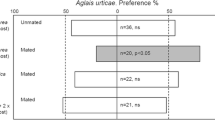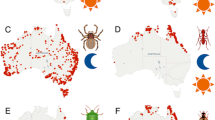Abstract
Herbivorous insects searching for a host plant need to integrate a sequence of multimodal sensory inputs. We conducted a series of no-choice experiments in a laboratory wind tunnel to examine the behavioral response of the specialist fruit fly, Neoceratitis cyanescens (Diptera: Tephritidae), to host visual and olfactory stimuli presented singly or in combination (e.g., colored fruit model with or without host fruit odor). We also studied the influence of wind flow, age, and sex on the response of flies. In two-choice experiments, we evaluated the ability of mature females to discriminate between two fruit models emitting host vs. non-host fruit odor or clean air. Neoceratitis cyanescens mature females can use independently or interactively olfactory and visual stimuli to locate their host, whereas immature females and males respond primarily to host fruit odor. In the absence of wind, mature females mainly use visual information to locate the host fruit. In wind, host fruit odor significantly increases the probability and speed of locating the host fruit. In a two-choice situation between two bright orange spheres, flies accurately detected the sphere emitting host fruit odor vs. non-host fruit odor or odorless air. Nevertheless, they preferred to land on the bright orange sphere when the sphere emitting host fruit odor was blue. Furthermore, when odor source and fruit model were spatially decoupled (90 or 180°), >50% flies that landed on the fruit model initially performed an oriented flight toward the odor source, then turned back to the fruit model while in flight or after one landing, thus suggesting visual information to be the ultimate indicator of host fruit.




Similar content being viewed by others
References
Aluja, M., and Prokopy, R. J. 1992. Host search behavior by Rhagoletis pomonella flies: inter-tree movement patterns in response to wind-borne fruit volatiles under field conditions. Physiol. Entomol. 17:1–8.
Aluja, M., and Prokopy, R. J. 1993. Host odor and visual stimulus interaction during intratree host finding behavior of Rhagoletis pomonella flies. J. Chem. Ecol. 19:2671–2696.
Averill, L. A., Reissig, W. H., and Roelofs, W. L. 1988. Specificity of olfactory responses in the tephritid fruit fly Rhagoletis pomonella. Entomol. Exp. App. 47:211–222.
Barton Browne, L., Smith, P. H., van Gerwen, A. C., and Gillott, C. 1990. Quantitative aspects of the effect of mating on readiness to lay in the Australian sheep blowfly, Lucilia cuprina. J. Insect Behav. 3:637–646.
Bell, W. J. 1990. Searching behavior patterns in insects. Annu. Rev. Entomol. 35:447–467.
Bell, W. J., Kipp, L. R., and Collins, R. D. 1995. Orientation mechanisms: the role of chemo-orientation in search behavior, pp. 105–153, in R. T. Cardé and W. J. Bell (eds.). Chemical Ecology of Insects. Chapman & Hall, New York.
Bernays, E. A., and Chapman, R. F. 1994. Behavior: the process of host-plant finding, pp. 95–116, in E. A. Bernays and R. F. Chapman (eds.). Host-Plant Selection by Phytophagous Insects. Chapman & Hall, New York.
Björklund, N., Nordlander, G., and Bylund, H. 2005. Olfactory and visual stimuli used in orientation to conifer seedlings by the pine weevil, Hylobius abietis. Physiol. Entomol. 30:225–231.
Brévault. T., and Quilici, S. 1999. Factors affecting behavioral responses to visual stimuli in the tomato fruit fly, Neoceratitis cyanescens. Physiol. Entomol. 24:333–338.
Brévault. T., and Quilici, S. 2000a. Diel patterns of reproductive activities in the tomato fruit fly, Neoceratitis cyanescens. Physiol. Entomol. 25:233–241.
Brévault, T., and Quilici, S. 2000b. Relationships between temperature, development and survival of different life stages of the tomato fruit fly, Neoceratitis cyanescens. Entomol. Exp. Appl. 94:25–30.
Brévault, T., and Quilici, S. 2007a. Visual response of the tomato fruit fly, Neoceratitis cyanescens, to colored fruit models. Entomol. Exp. Appl. 125:45–54.
Brévault, T., and Quilici, S. 2007b. Influence of habitat pattern on visual orientation during host finding in the tomato fruit fly, Neoceratitis cyanescens. Bull. Entomol. Res. 97:1–6.
Brévault, T., and Quilici, S. 2010. Flower and fruit volatiles assist host plant location in the Tomato fruit fly, Neoceratitis cyanescens. Physiol. Entomol. 35:9–18.
Campbell, S. A., and Borden, J. H. 2006. Close-range, in-flight integration of olfactory and visual information by a hostseeking bark beetle. Entomol. Exp. Appl. 120:91–98.
Cardé, R. T. 1984. Chemo-orientation in flying insects, pp 111–124, in W. J. Bell and R. T. Cardé (eds.). Chemical Ecology of Insects. Chapman & Hall, London.
Cardé, R. T., and Willis, M. A. 2008. Navigational strategies used by insects to find distant, Wind-Borne sources of odor. J. Chem. Ecol. 34:854–866.
Duan, J. J., and Prokopy, R. J. 1994. Apple maggot fly response to red sphere traps in relation to fly age and experience. Entomol. Exp. Appl. 73:279–287.
Etienne, J. 1973. Elevage permanent de Pardalaspis cyanescens (Diptera : Tephritidae) sur hôte végétal de remplacement. Ann. Soc. Entomol. Fr. 9:853–860.
Fahmy, T. 2006. XLStat, version 2006. Addinsoft, Paris.
Fawcett, T. W., and Johnstone, R. A. 2003. Optimal assessment of multiple cues. Proc. R. Soc. London B., 270:1637–1643.
Fein, B. L., Reissig, W. H., and Roelofs, W. L. 1982. Identification of apple volatiles attractive to apple maggot fly. J. Chem. Ecol. 8:1473–1487.
Finch, S., and Collier, R. H. 2000. Host-plant selection by insects: a theory based on ‘appropriate/inappropriate landings’ by pest insects of cruciferous plants. Entomol. Exp. Appl. 96:91–102.
Forbes, A. A., and Feder, J. L. 2006. Divergent preferences of Rhagoletis pomonella host races for olfactory and visual fruit cues. Entomol. Exp. Appl. 119:121–127.
Goyret, J., Markwell, P. M., and Raguso, R. 2007. The effect of decoupling olfactory and visual stimuli on the foraging behavior of Manduca sexta. J. Exp. Biol. 210:1398–1405.
Green, T. A., Prokopy, R. J., and Hosmer, D. W. 1994. Distance of response to host tree models by female apple maggot flies, Rhagoletis pomonella (Walsh) (Diptera: Tephritidae): interaction of visual and olfactory stimuli. J. Chem. Ecol. 20:2393–2413.
Hancock, D. L., and White, I. M. 1997. The identity of Trirhithrum nigrum (Graham) and some new combinations in Ceratitis MacLeay (Diptera:Tephritidae). Entomologist 116:192–197.
Jang, E. B., Messing, R. H., Klungness, L. M., and Carvalho, L. A. 2000. Flight tunnel responses of Diachasmimorpha longicaudata (Ashmead) (Hymenoptera: Braconidae) to olfactory and visual stimuli. J. Insect Behav. 13:525–538.
Katsoyannos, B. I. 1989. Response to shape, size and color, pp. 307–324, in A. S. Robinson and G. Hooper (eds.). Fruit Flies, Their Biology, Natural Enemies and Control. World Crop Pests 3B, Elsevier, Amsterdam.
Kulahci, I. G., Dornhaus, A., and Papaj, D. R. 2008. Multimodal signals enhance decision making in foraging bumble-bees. Proc. R. Soc. B 275:797–802.
Landolt, P. J., and Molina, O. 1996. Host-finding by cabbage looper moths (Lepidoptera: Noctuidae): learning of host odor upon contact with host foliage. J. Insect Behav. 9:899–908.
Linn Jr, C. E., Feder, J. L., Nojima, S., Dambroski, H. R., Berlocher, S. H., and Roelofs, W. L. 2003. Fruit odor discrimination and sympatric host race formation in Rhagoletis. Proc. Nat. Acad. Sci. USA 100:11490–11493.
Linn, C. E. Jr, Nojima, S., and Roelofs, W. L. 2004. Antagonistic effects of non-host fruit volatiles on discrimination of host fruit by Rhagoletis pomonella flies infesting apple (Malus spp.), hawthorn (Crataegus spp.), and flowering dogwood (Cornus florida). Entomol. Exp. Appl. 114:97–106.
Linn, C. E. Jr, Dambroski, H. R., Nojima, S., Feder, J. L., Berlocher, S. H., and Roelofs, W. L. 2005. Variability in response specificity of apple, hawthorn, and flowering dogwood-infesting Rhagoletis flies to host fruit volatile blends: implications for sympatric host shifts. Entomol. Exp. Appl. 116:55–64.
Morehead, S. A., and Feener, D. H. 2000. Visual and chemical cues used in host location and acceptance by a dipteran parasitoid. J. Insect Behav. 13:613–625.
Nojima, S., Linn, C.E. Jr, and Roelofs, W. L. 2003a. Identification of host fruit volatiles from flowering dogwood (Cornus florida) attractive to dogwood-origin Rhagoletis pomonella flies. J. Chem. Ecol. 29:2347–2357.
Nojima, S., Linn, C.E. Jr, Zhang, A., Morris, B., and Roelofs, W. L. 2003b. Identification of host fruit volatiles from hawthorn (Crataegus spp.) attractive to hawthorn-origin Rhagoletis pomonella flies. J. Chem. Ecol. 29:319–334.
OEPP/EPPO-CABI. 1997. Quarantine Pests for Europe. 2nd edn. OEPP/CABI.
Papaj, D. R. 2000. Ovarian dynamics and host use. Annu. Rev. Entomol. 45:423–448.
Prokopy, R. J., and Owens, E. D. 1983. Visual detection of plants by herbivorous insects. Annu. Rev. Entomol. 28:337–364.
Prokopy, R. J., and Roitberg, B. D. 1984. Foraging behavior of true fruit flies [Tephritidae]. Am. Sci. 72:41–49.
Prokopy, R. J., Green, T. A., and Vargas, R. I. 1990. Dacus dorsalis flies can learn to find and accept host fruit. J. Insect Behav. 3:663–672.
Prokopy, R. J., Bergweiler, C., Galarza, L., and Schwerin, J. 1994. Prior experience affects the visual ability of Rhagoletis pomonella flies (Diptera: Tephritidae) to find host fruit. J. Insect Behav. 7:663–677.
Rausher, M. D. 1978. Search image for leaf shape in a butterfly. Science 34:342–355.
Roitberg, B. D. 1985. Search dynamics in fruit-parasitic insects. J. Insect Physiol. 31:865–872.
Schoonhoven, L. M., Van Loon, J. J. A., and Dicke, M. 2005. Insect-Plant Biology. 2nd ed. Oxford University Press, Oxford.
Szentesi, A., Hopkins, T. L., and Collins, R. D. 1996. Orientation responses of the grasshopper, Melanoplus sanguinipes, to visual, olfactory, and wind stimuli and their combinations. Entomol. Exp. Appl. 80:539–549.
Todd, J. L., Phelan, P. L., and Nault, L. R. 1990. Interaction between visual and olfactory stimuli during host-finding by leafhopper, Dalbulus maidis (Homoptera: Cicadellidae). J. Chem. Ecol. 16:2121–2133.
Vet, L. E. M., Lewis, W. J., Papaj, D. R., and van Lenteren, J. C. 1990. A variable-response model for parasitoid foraging behavior. J. Insect Behav. 3:471–490.
Vet, L. E. M., Lewis, W. J., and Cardé, R. T. 1995. Chemoreception and integration: Parasitoid foraging and learning, pp. 65–101, in R. T. Cardé and W. J. Bell (eds.). Chemical Ecology of Insects. Chapman & Hall, New York.
Wackers, F. L., and Lewis, W. J. 1993. Olfactory and visual learning and their combined influence on host location by the parasitoid Microplitis croceipes (Cresson). Biol. Control 4:105–112.
Zhang, A. J., Linn, C., Wright, S., Prokopy, R. J., Reissig, W., and Roelofs, W. 1999. Identification of a new blend of apple volatiles attractive to the apple maggot, Rhagoletis pomonella. J. Chem. Ecol. 25:1221–1232.
Acknowledgments
This research was supported by the Région Réunion and the European Union - Commission de l’Océan Indien, Programme Régional de Recherche appliquée sur les Mouches des Fruits, Convention N° 7.ACP.RPR.400ID N° REG (RIN) 7502. We thank the anonymous reviewers for their helpful comments on previous versions of this manuscript.
Author information
Authors and Affiliations
Corresponding author
Rights and permissions
About this article
Cite this article
Brévault, T., Quilici, S. Interaction Between Visual and Olfactory Cues During Host Finding in the Tomato Fruit Fly Neoceratitis cyanescens . J Chem Ecol 36, 249–259 (2010). https://doi.org/10.1007/s10886-010-9766-6
Received:
Revised:
Accepted:
Published:
Issue Date:
DOI: https://doi.org/10.1007/s10886-010-9766-6




